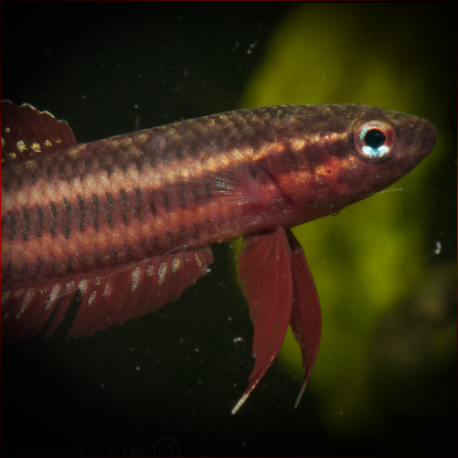More info
Datasheet
| Minimum Tank Size | 40 litres / 10.57 US gallons |
| Maximum Size | 3.7cm / 1.46inches |
| Temperature | 22°C / 71.60°F - 27°C / 80.60°F |
| Hardness | 1.01dgH / 18ppm - 5.04dgH / 90ppm |
| pH | 3.0-6.0 |
General Description
Betta Tussyae, a member of the B. coccina group, is a small species known for its red-colored body and distinct characteristics such as faint gold-colored parallel vertical bars on the opercle. This species, like other Betta members, features an accessory breathing organ called the labyrinth, allowing it to breathe atmospheric air to some extent. Endemic to coastal regions of Pahang and Terengganu states in eastern Peninsular Malaysia, it is an obligate inhabitant of peat swamps and blackwater streams, thriving in low pH and soft water conditions.
Aquarium Setup
Betta Tussyae is best maintained in a setup with driftwood, roots, branches, and dried leaf litter to simulate its natural habitat. Providing hiding places with clay plant pots or piping is essential, along with the inclusion of floating vegetation. This species thrives in acidic water with low hardness, necessitating the use of soft water sources and gentle filtration. Tank lighting should be kept dim, and occasional access to a layer of humid air above the water surface is vital as they are skilled jumpers.
Behaviour
Due to its care requirements and timid nature, Betta Tussyae is not suitable for standard community setups. It is advised to keep this species either alone or with very peaceful tankmates to prevent intimidation or competition for resources. If kept in a group, ample hiding spots and limited lines of sight are crucial, although isolating pairs for breeding purposes may be preferable.
Feeding and Diet
In the wild, Betta Tussyae feeds on insects and small invertebrates. In captivity, they readily accept dried foods but should be supplemented with live or frozen options like Daphnia and bloodworms for optimal color and health. Overfeeding should be avoided, as Betta species are prone to obesity.
Reproduction & Dimorphism
Betta Tussyae is a bubble-nester and requires ample cover and nesting sites for successful breeding. During spawning, males exhibit vibrant colors and develop longer fins compared to females. The male constructs the nest and guards the brood, while the female is less involved post-spawning. Fry hatch in 24-48 hours and can be fed microworms and Artemia nauplii, with care taken not to overfeed the young fish.
Habitat and Distribution
This species is primarily found in peat swamps and blackwater streams in Malaysia. The dense canopy above these habitats limits light penetration, resulting in darkly stained water with minimal dissolved minerals. Betta Tussyae is endemic to coastal areas of Pahang and Terengganu, with different populations labeled by collectors to preserve genetic purity and accuracy.

